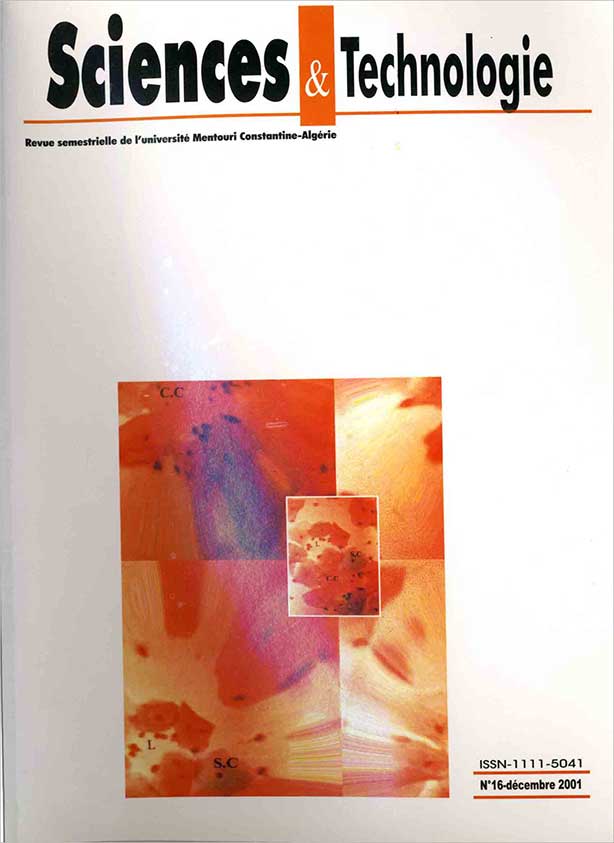MODULATION DE L’INSULINO-SECRETION PAR LES CYTOKINES CHEZ LE RAT DES SABLES ET LE RAT WISTAR: ETUDE INTERSPECIFIQUE
الكلمات المفتاحية:
diabète، insuline، rat Wistar، rat des sables، cytokineالملخص
Le diabète de type I est un processus chronique, secondaire à la destruction sélective et progressive du potentiel insulino-sécréteur par le système immunitaire. Les différentes populations de cellules immunitaires ont été toutes mises en cause; mais à l’heure actuelle, le degré d’implication de chaque type cellulaire ainsi que leurs mécanismes d’action restent encore mal connus. Au cours de cette dernière décennie, nous avons assisté à l’émergence d’un nouveau concept, selon lequel les produits de sécrétion des cellules immunitaires désignés sous le terme générique de cytokines pourraient prendre une part importante dans le processus pathogène du DID.
Dans cette étude, nous avons comparé l’activité insulinosécrétoire des îlots de Langerhans isolés du rat Wistar et du rat des sables, afin de déterminer les variation interspécifiques. Nos résultats préliminaires indiquent que l'effet le plus probant est observé en présence de l’IL-1b. En effet, cette cytokine stimule la sécrétion d’insuline de manière dose-dépendante également chez le rat des sables; toutefois, l'amplitude de la réponse est plus prononcée chez le rongeur désertique, avec une augmentation du taux de l’insuline libérée de l’ordre de 147%, en présence d’une concentration de 20 UI/ml de l’IL-1b, comparée à la sécrétion basale. Quant à l’IL-2, nous n’avons enregistré aucune modification dans l’activité insulinosécrétoire des 2 espèces.التنزيلات
المراجع
- Srikanta J.P., Holqvist S., Spinas G.A., Mandrup-Poulsen T. and Nerup G., "Interaction of -cell activity and interleukin-1 concentration and exposure time in isolated islets of Langerhans", Diabetes, 38, (1989), pp. 1211-1216.
- Froguel P., "Génétique du diabète non insulino-dépendant (DNID)", Actual. Diabet. Aron Medica, (Paris), 27, (1991), pp. 1- 11.
- Gepts W. and Le Copmte P.M., "The pathology of type-1 (juvenile) diabetes", Am. J. Med., 70, (1985), pp. 105-115.
- Nakhoda A.F., Like A.A., Chapel C.L. and Murray E.T., "The spontaneously diabetic Wistar rat. Metabolic and morphological studies", Diabetes 26, (1976), pp. 100-112.
- Fijita T., Yui R., Kumosoto R. and Serizawa Y., "Lymphocytes insulitis in a non obese diabetic NOD stain of mice": an immunohistochemical and electron microscope investigation", Biomed. Res. 9, (1992), pp. 429-433.
- Oscilewski U., Kiesel U. and Kolb H., "Administration of silica prevents diabetes in BB rats", Diabetes 34, (1985), pp. 197-199.
- Ku L., Pak C.Y., Amano K. and Yoon J.W., "Prevention of lymphocytic thyroiditis and insulitis in diabetes prone BB rats by the depletion of macrophages", Diabetologia, 31, (1988), pp. 400-402.
- Reich E.P., Janeway C., Rath S. and Shervin R.S., "The islets specific T-cells clones from diabetes NOD mice can cause histological insulitis", Diabetes, 38 (suppl.2), (1989), pp. 1-13.
- Ellas D., Reshef T., Birk O.S. and Van Der Zee R., "Vaccination aggaint autoimmune mouse diabetes with T-cell epitope of the human 65 Kda heat shok protein", Proc. Natrl. Acad. Sci. (USA) 88, (1991), pp. 3080-3093.
-Like A.A., Biron C.A., Weringer E.G. and Byman K., "Prevention of diabetes in BioBreeding /Worcester rats with monoclonal antibodies that recognize T lymphocytes or natural killer celles", J. Exper. Med., 16664, (1986), pp. 1145-1159.
-Mandrup-Poulsen T., Bendtzen K., Nerup G. and Egberg J., "Mechanisms of pancreatic islet cell destruction. Dose-dependent cytotoxic effect of soluble blood mononuclear cell mediators on isolated islets of Langerhans", Allergy, 41, (1986), pp. 250-259.
-Sandler S., Andersson A. and Hellerstrôm P., "Inhibitory effects of interleukin-1 on pancreatic (-cells", Autoimmunity, 121, (1987), pp. 1424-1431.
-Eizirik D.L., "Interleukin-1 induced impaiement in pancreatic islet oxidative metabolism of glucose is potentiated by tumor necrosis factor", Acta endocrinol (Copenh.), 119, (1988), pp. 321-325.
-Palmer J.P., Helqvist S., Spinas G.A., Mandrup-Poulssen T. and Nerup G., "Interaction of (-cell activity and Interleukin-1 concentration and exposure time in isolated rat islets of Langerhans", Diabetes, 38, (1989), pp. 1211-1216.
-Borg L.A.H. and Eizerik D.L., "Short term exposure of rat pancreatic islets of haman Interleukin-1 increases cellular uptake of calcium", Immunol. Lett., 26, (1990), pp. 253-258.
-Marquie G., Duhault J. et Jacotot B., "Etude métabolique d’un syndrome diabétique d’ordre nutritionnel chez le rar des sables (Psammomys obesus). Un modèle animal du diabète humain de la maturité et de l’obésité", Bull. Soc. Hist. Natur. (Alger), (1980), pp. 113-115.
-Malaise W.J., Like A.A., Malaise-Lagae F. and Cleason R.E., "Diabetes insulin secretion in vitro by the pancreas of sand rat (Psammomys obesus)", Diabetes, 5, (1968), pp. 752-759.
-Dahmani Y., "Approche biologique d’un modèle experimental pour l’étude du diabète: le rat des sables (Psammomys obesus). Morphologie du pancréas endocrine et le métabolisme de l’adipocyte après un régime hypo- et hypercalorique", Mémoire de Magister, USTHB, Alger (1981).
-Khalkhal A., "Influence du régime restrictif sur les troubles lipidiques et les complications vasculaires chez le rat des sables (Psammomys obesus) rendu diabètique, stade de la maturité, par un régime hyperacalorique enrichi en cholestérol", Mémoire de Magister, USTHB, Alger (1990).
-Haddar A., "Effets des cytokines sur l’insulinosécrétion in vitro chez le rat des sables (normal, obèse et diabètique) et le rat Wistar. Influence du jeûne", Mémoire de Magister, USTHB, Alger (1995).
-Lacy P.E. and Kostianovsky M.D., "Method for isolation of intact islets of Langerhans from the rat pancreas", Diabetes 16 (01), (1967), pp. 35-39.
-Cavaillon J.M., "Les cytokines", Flammarion (Ed.), Paris (1993).
-Mandrup-Poulssen T., Helqvist S., Molvig J. and Nerup G., "Cytokines as immune effector molecules in autoimmune endocrine disease with special reference to insulin-dependent diabetes mellitus", Autoimmunity, 4, (1989), pp. 191-218.
-Deschaux P.A., "Immunité et physiologie", Arch. Inter. Physiol. Bioch. Biophys. (Paris), 101, (1993), pp. 3-8.
-Spinas G.A., Palmer G.P., Mandrup-Poulssen T. and Andersen H., "The bimodal effect of interleukin-1 on rat pancreatic beta-cells: stimulation followed by inhibition-depends upon dose, duration of exposure and ambient glucose concentration", Acta endocrinologica (Copenh.), 27, (1988), pp. 307-311.
-Purrello F. and Buscema M., (1993), "Effects of interleukin-1 on insulin secretion by pancreatic (-cell", Diab. Nutri. Mutab., 6, pp. 2955-304.
-Corbett J.A., Wang J.L., Misko T. and Langaster J.R., "IL-1 (induces formation of nitric oxide by (-cell purified from rodent islets of Langerhans; evidence for the (-cell as a source and site of action of nitric oxide", J. Clin. Invest., 90, (1992), pp. 2384-2391.
-Andersen H.U., Jorgensen K.H., Egeberg G., Mandrup-Poulsen T. and Nerup G., "Nicotinamide prevents Interleukin-1 effects on accumulated insulin release and nitric oxide production in rat islets of Langerhans", Diabetes care 43, (1994), pp. 770-777.
-Antoine M.H., Oudraogo R., Segooris J. and Lebrun P.,
"Hydroxylamine, a nitric oxide donor, inhibits insulin release and activates K+ATP chanels", Eur. J. Pharmacol. 313, (1996), pp. 229-235.
-Dunger A., Cunningham J.M., Dalaney A.E. and Welsh J.E., "Tumor necrosis factor alpha and interferon gamma inhibit insulin secretion and causes DNA damage in unweaned rat islets. Extent of nitric oxide involvement", Diabetologia, 45, 2, (1996), pp. 183-189.
-Eiziric D.L., Flodstrom M., Karlsen A.E. and Welsh N., "Inducibles nitric oxide sytnhetase and related genes in pancreatic B-cells", Diabetologia,39, 08, (1996), pp. 875-890.
-Rasschaert J., Deng Y. and Malaise W.J., "Presence of the calicium-sensing receptor in islet -cells", Diabetologia, 41, (1998), pp. 126-140.
-Squires Pe., Non-Ca2+ ho;eostqtic functions of the extracellular Ca2+ sensing receptor (CaR) in endocrine tissues", J. endocrinol., 165, (2000), pp.173-177.
-Handler E.S., Mordes J.P., Seals J. and Koevary S., "Diabetes in the BioBreeding/Worcester rat. Induction and acceleration by spleen cell-conditionned media", J. Clin. Invest., 76, (1985), pp. 1113-1139.
-Rhodes C.J. and Taylor K.W., "Effects of human lymphoblastoid interferon on insulin synthesis and secretion in isolated pancreatic islets", Diabetologia, 27, (1984), pp. 601-603.
-Rabinivithc A., Suarez W.L., Thomas P.D. and Strynadka K.N., "Cytotoxic effects of cytokines on rat islets: evidence for involvement of free radicals and lipid peroxidation", Diabetologia, 35, (1992), pp. 409-413.







